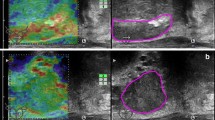Abstract
Objectives
To analyze the diagnostic value of adding SWE to MRI for the diagnosis of clinically significant prostate cancer with false-negative MRI results.
Methods
This was a retrospective study of 367 patients who underwent MRI, SWE, and prostate biopsy between March 2016 and November 2018 at the Shanghai Tenth People’s Hospital. Serum prostate-specific antigen (PSA) and free PSA (fPSA) were measured preoperatively. Diagnostic value and accuracy was determined for MRI alone and MRI + SWE using the receiver operator characteristic curve (ROC) analysis.
Results
MRI misdiagnosed 17.9% (21/117) clinically significant prostate cancers, including 15 lesions in the peripheral zone and 6 in the central zone. Both qualitative and quantitative SWE could help detect 66.7% (10/15) significant prostate cancers with false-negative MRI, but there was no association with the Gleason score (p > 0.05). When considering the sextant of the peripheral zone, a significant association was not seen with histopathology in qualitative SWE (p = 0.071) and quantitative SWE (p = 0.598). Among age, PSA, fPSA, volume of the prostate gland, fPSA/PSA, and PSAD, only PSAD (p = 0.019) was associated with SWE results in patients with negative MRI.
Conclusions
Adding SWE to MRI in patients with negative MRI for prostate examination could allow the correct diagnosis of additional patients and reduce the false-negative rate.
Key Points
• MRI plays an important role in clinically significant prostate cancers diagnosis.
• SWE plays an important role in clinically significant prostate cancers with negative MRI.
• Adding SWE to MRI in patients with negative MRI for prostate examination could allow the correct diagnosis of additional patients and reduce the false-negative rate.


Similar content being viewed by others
Abbreviations
- 95%CI:
-
95% confidence intervals
- ADC:
-
Apparent diffusion coefficient
- AHH:
-
Atypical adenomatous hyperplasia
- AP/CP:
-
Acute/chronic prostatitis
- ASAP:
-
Atypical small acinar hyperplasia
- AUC:
-
Area under the ROC
- BPH:
-
Benign prostatic hyperplasia
- DCE:
-
Dynamic contrast enhancement
- DWI:
-
Diffusion-weighted imaging
- fPSA:
-
Free PSA
- HGPIN:
-
High-grade prostate intraepithelial neoplasia
- LGPIN:
-
Low-grade prostate intraepithelial neoplasia
- mp-MRI:
-
Multiparameter magnetic resonance imaging
- NCI:
-
National Cancer Institute
- NPV:
-
Negative predictive value
- NSGP:
-
Non-specific granulomatous prostatitis
- PCa:
-
Prostate cancer
- PI-RADS:
-
Prostate Imaging Reporting and Data System
- PPV:
-
Positive predictive value
- PSA:
-
Prostate-specific antigen
- PSAD:
-
PSA density
- ROC:
-
Receiver operator characteristic
- ROI:
-
Region of interest
- sPCa:
-
Clinically significant prostate cancer
- SWE:
-
Shear-wave elastography
- T1WI:
-
T1-Weighted imaging
- T2WI:
-
T2-Weighted imaging
- TRUS-Bx:
-
Transperineal prostate biopsy guided by transrectal ultrasound
- US:
-
Ultrasound
- V:
-
Volume of the prostate gland
References
Leslie SW, Soon-Sutton TL, Siref LE (2017) Cancer, prostate. StatPearls. StatPearls Publishing, Treasure Island (2017) Cancer, prostate. StatPearls. StatPearls Publishing StatPearls Publishing LLC, Treasure Island
Zheng R, Zeng H, Zhang S, Chen W (2017) Estimates of cancer incidence and mortality in China, 2013. Chin J Cancer 36:66
Wong MC, Goggins WB, Wang HH et al (2016) Global incidence and mortality for prostate cancer: analysis of temporal patterns and trends in 36 countries. Eur Urol 70:862–874
Weinreb JC, Barentsz JO, Choyke PL et al (2016) PI-RADS Prostate Imaging - Reporting and Data System: 2015, version 2. Eur Urol 69:16–40
Borofsky S, George AK, Gaur S et al (2018) What are we missing? False-negative cancers at multiparametric MR imaging of the prostate. Radiology 286:186–195
Correas JM, Tissier AM, Khairoune A et al (2015) Prostate cancer: diagnostic performance of real-time shear-wave elastography. Radiology 275:280–289
Woo S, Suh CH, Kim SY, Cho JY, Kim SH (2017) Shear-wave elastography for detection of prostate cancer: a systematic review and diagnostic meta-analysis. AJR Am J Roentgenol 209:806–814
Sang L, Wang XM, Xu DY, Cai YF (2017) Accuracy of shear wave elastography for the diagnosis of prostate cancer: a meta-analysis. Sci Rep 7:1949
Hamoen EHJ, de Rooij M, Witjes JA, Barentsz JO, Rovers MM (2015) Use of the Prostate Imaging Reporting and Data System (PI-RADS) for prostate cancer detection with multiparametric magnetic resonance imaging: a diagnostic meta-analysis. Eur Urol 67:1112–1121
Niu XK, Chen XH, Chen ZF, Chen L, Li J, Peng T (2018) Diagnostic performance of biparametric MRI for detection of prostate cancer: a systematic review and meta-analysis. AJR Am J Roentgenol 211:369–378
Tan CH, Wei W, Johnson V, Kundra V (2012) Diffusion-weighted MRI in the detection of prostate cancer: meta-analysis. AJR Am J Roentgenol 199:822–829
Su R, Xu G, Xiang L, Ding S, Wu R (2018) A novel scoring system for prediction of prostate cancer based on shear wave elastography and clinical parameters. Urology 121:112–117
Furlan A, Borhani AA, Westphalen AC (2018) Multiparametric MR imaging of the prostate: interpretation including Prostate Imaging Reporting and Data System version 2. Radiol Clin North Am 56:223–238
de Rooij M, Hamoen EH, Fütterer JJ, Barentsz JO, Rovers MM (2014) Accuracy of multiparametric MRI for prostate cancer detection: a meta-analysis. AJR Am J Roentgenol 202:343–351
Mazaheri Y, Akin O, Hricak H (2017) Dynamic contrast-enhanced magnetic resonance imaging of prostate cancer: a review of current methods and applications. World J Radiol 9:416–425
Nazim SM, Ather MH, Salam B (2018) Role of multi-parametric (mp) MRI in prostate cancer. J Pak Med Assoc 68:98–104
Abd-Alazeez M, Kirkham A, Ahmed HU et al (2014) Performance of multiparametric MRI in men at risk of prostate cancer before the first biopsy: a paired validating cohort study using template prostate mapping biopsies as the reference standard. Prostate Cancer Prostatic Dis 17:40–46
Benndorf M, Waibel L, Krönig M, Jilg CA, Langer M, Krauss T (2018) Peripheral zone lesions of intermediary risk in multiparametric prostate MRI: frequency and validation of the PI-RADSv2 risk stratification algorithm based on focal contrast enhancement. Eur J Radiol 99:62–67
Zuo MZ, Zhao WL, Wei CG et al (2017) Preliminary applicability evaluation of Prostate Imaging Reporting and Data System version 2 diagnostic score in 3.0T multi-parameters magnetic resonance imaging combined with prostate specific antigen density for prostate cancer. Zhonghua Yi Xue Za Zhi 97:3693–3698
Krishna S, McInnes M, Lim C et al (2017) Comparison of Prostate Imaging Reporting and Data System versions 1 and 2 for the detection of peripheral zone Gleason score 3 + 4 = 7 cancers. AJR Am J Roentgenol 209:W365–w373
Becker AS, Cornelius A, Reiner CS et al (2017) Direct comparison of PI-RADS version 2 and version 1 regarding interreader agreement and diagnostic accuracy for the detection of clinically significant prostate cancer. Eur J Radiol 94:58–63
Polanec S, Helbich TH, Bickel H et al (2016) Head-to-head comparison of PI-RADS v2 and PI-RADS v1. Eur J Radiol 85:1125–1131
Futterer JJ, Briganti A, De Visschere P et al (2015) Can clinically significant prostate cancer be detected with multiparametric magnetic resonance imaging? A systematic review of the literature. Eur Urol 68:1045–1053
Thompson JE, van Leeuwen PJ, Moses D et al (2016) The diagnostic performance of multiparametric magnetic resonance imaging to detect significant prostate cancer. J Urol 195:1428–1435
Harvey H, Morgan V, Fromageau J, O’Shea T, Bamber J, deSouza NM (2018) Ultrasound shear wave elastography of the normal prostate: interobserver reproducibility and comparison with functional magnetic resonance tissue characteristics. Ultrason Imaging 161734618754487. https://doi.org/10.1177/0161734618754487
Hoyt K, Castaneda B, Zhang M et al (2008) Tissue elasticity properties as biomarkers for prostate cancer. Cancer Biomark 4:213–225
Good DW, Stewart GD, Hammer S et al (2014) Elasticity as a biomarker for prostate cancer: a systematic review. BJU Int 113:523–534
Salomon G, Köllerman J, Thederan I et al (2008) Evaluation of prostate cancer detection with ultrasound real-time elastography: a comparison with step section pathological analysis after radical prostatectomy. Eur Urol 54:1354–1362
Walz J, Marcy M, Pianna JT et al (2011) Identification of the prostate cancer index lesion by real-time elastography: considerations for focal therapy of prostate cancer. World J Urol 29:589–594
Brock M, von Bodman C, Palisaar RJ et al (2012) The impact of real-time elastography guiding a systematic prostate biopsy to improve cancer detection rate: a prospective study of 353 patients. J Urol 187:2039–2043
Bercoff J, Tanter M, Fink M (2004) Supersonic shear imaging: a new technique for soft tissue elasticity mapping. IEEE Trans Ultrason Ferroelectr Freq Control 51:396–409
Barr RG, Memo R, Schaub CR (2012) Shear wave ultrasound elastography of the prostate: initial results. Ultrasound Q 28:13–20
Zhang M, Wang P, Yin B, Fei X, Xu XW, Song YS (2015) Transrectal shear wave elastography combined with transition zone biopsy for detecting prostate cancer. Zhonghua Nan Ke Xue 21:610–614
Schouten MG, van der Leest M, Pokorny M et al (2017) Why and where do we miss significant prostate cancer with multi-parametric magnetic resonance imaging followed by magnetic resonance-guided and transrectal ultrasound-guided biopsy in biopsy-naive men? Eur Urol 71:896–903
Funding
This study has received funding through Grant SHDC12016233 from the Shanghai Hospital Development Center, Grant 17411967400 from the Science and Technology Commission of Shanghai Municipality, and Grants 81471673 and 81671699 from the National Natural Science Foundation of China.
Author information
Authors and Affiliations
Corresponding author
Ethics declarations
Guarantor
The scientific guarantor of this publication is Rong Wu.
Conflict of interest
The authors of this manuscript declare no relationships with any companies, whose products or services may be related to the subject matter of the article.
Statistics and biometry
No complex statistical methods were necessary for this paper.
Informed consent
Written informed consent was obtained from all subjects (patients) in this study.
Ethical approval
Institutional Review Board approval was obtained.
Methodology
• retrospective
• diagnostic or prognostic study
• performed at one institution
Additional information
Publisher’s note
Springer Nature remains neutral with regard to jurisdictional claims in published maps and institutional affiliations.
Electronic supplementary material
ESM 1
(DOCX 9660 kb)
Rights and permissions
About this article
Cite this article
Xiang, LH., Fang, Y., Wan, J. et al. Shear-wave elastography: role in clinically significant prostate cancer with false-negative magnetic resonance imaging. Eur Radiol 29, 6682–6689 (2019). https://doi.org/10.1007/s00330-019-06274-w
Received:
Revised:
Accepted:
Published:
Issue Date:
DOI: https://doi.org/10.1007/s00330-019-06274-w




